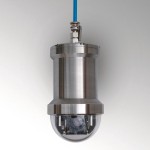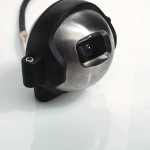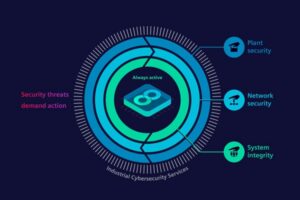For the surveillance of working areas, for production flow control, reactor monitoring or similar tasks options are available in the form of modern network and video technology also for hazardous areas. The signals of one or more cameras can be integrated into process images at any operating station in a user-friendly way. It is also possible to remote control the video technology via the control system. This can be implemented with the aid of the ActiveX and OPC software interfaces.
The long-established standard in camera surveillance is the transfer of analog images in the form of a TV signal in CVS format (composite video signal), which today usually achieves the full resolution of the PAL or NTSC TV standard. This signal is generally used directly for full-screen viewing, for recording or for the display on a split-screen for several image sources. Conventional surveillance systems, however, usually only transfer an image to a few, specific monitoring stations, which cannot be expanded easily. Network-based video technologies are more modern and more flexible in this regard. Either direct use is made of IP cameras, or the analog images of the CVS cameras are digitalised by means of video servers. Software is required to display or process the video images. For smaller configurations where no recording is required, R. Stahl has been offering the Smart Display tool for quite some time now. For more complex surveillance systems, larger CCTV projects can be implemented with the ProBox 5/10/15 package or the ProBox Enterprise Edition for any number of cameras. This software offers additional features, such as an integrated motion detector or the option of informing staff via E-mail, text message or network protocols in case of an alarm.
Independent of which software solution is being used, conventional systems require the operating staff to keep an eye on a surveillance monitor located in the control room, in addition to other screens and displays. Having to watch such a separate screen can be quite impractical, particularly in cases where staff simultaneously have to control cameras, view their images, monitor processes and operate plant systems. Even more problems arise if the camera images can only be viewed on special monitors but would also be useful or even essential at other stations in the plant. This can only be remedied by CCTV systems that are fully integrated into the plant’s control system. Their video signals are available at any HMI operating station and at the control station, and can easily be integrated into the process images on these screens. If required, the cameras can even be directly controlled from these stations.
Integration via ActiveX und OPC
Solutions of this type can provide access via Ethernet to the digital video data from anywhere within the higher-level IT infrastructure. The pan, tilt and zoom functions of cameras can be more flexibly controlled via Ethernet connections than via the conventional serial connections. With regard to the software, images and controls can be integrated in various ways. As a rule, the integration of camera signals into a control system requires project-specific implementation by a programmer. Depending on which technical solution is chosen the requirements of the current visualisation systems vary greatly.
The most user-friendly solution by far for the integration of video signals has proven to be ActiveX-Controls, which is why R. Stahl has decided to make use of it. A camera view can be allocated to a process image window simply by dropping and briefly parameterising a Drag&Drop object. However, as simple as the integration of images may be with the help of ActiveX, as complicated is the control of camera movements with this tool. Many control systems hinder or block the data transfer for such functions, and ensuring a reliable control function with this tool would be quite a complicated task. The clearly more effective solution for these kinds of tasks is provided by the non-proprietary OPC interface (OLE for Process Control), which is based on the Microsoft COM and DCOM technologies for distributed applications. The great advantage of the OPC standard is that it is supported by all current automation systems and is implemented in these as a standardised I/O interface. Additionally, a range of ready-made, comfortable tools for control functions such as camera pans are available.
Three camera types
R. Stahl provides three camera types suitable for CCTV in plants with hazardous areas. All of them are of a mechanically robust design and achieve up to protection type IP 68. Each model has its own specific features: The first model, the EC-730 autofocus camera, comes with an optical zoom providing up to 22x magnification. Added to that is the 11x digital zoom. The EC-730 is suitable for ambient temperatures ranging from -30 to +50 °C. Its seawater-proof aluminum housing protects the camera against aggressive salty air and spray. The camera is mounted in a pivotable and revolvable position. Thanks to its zero-lux night vision mode the camera is suitable for round-the-clock surveillance, since it can capture and transfer useable images even in the darkest environments. Its 1/4“-CCD sensor provides a high-resolution image of 480 TV-lines.
The second model is the compact, spherical EC-710–090 which, due to its diameter of only 55 mm, fits into the smallest spaces. The optical system is protected by a chemically hardened lens. Even with the steel housing it weighs no more than 435 g and still resists ambient aggressive chemical substances as well as substantial mechanical stress, including vibrations. Its 1/3“-CCD sensor provides a high-resolution image of 470 TV-lines. The fixed camera viewing angle is ±90° horizontally and 68° vertically. Moreover, this camera can withstand extreme temperatures ranging from -30 to +75 °C, making it suitable for universal application in installations worldwide.
The third model is located under a transparent dome. This way, the EC-750 Ex-camera offers maximum flexibility, particularly for an all-round view. It also has a night vision mode, and a 18x zoom. The powerful EC-750 has a few additional features, too: As an option, this camera type can also be directly integrated into digital networks via its own IP interface. The intelligent model can furthermore follow up to 64 programmable positions and paths.
Online-Info www.cpp-net.com/2309431
Share:








